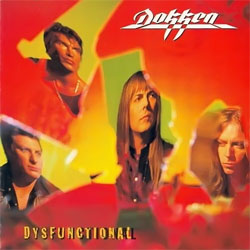Lynch Tone on ‘Lesser of 2 Evils’
Dokken’s Dysfunctional album isn’t great. Maybe not even good. They know it, I know it, now you know it. But there are a couple good tunes on it, and one I’d call great – great hard rock. Not metal, not pop metal, but big guitars, catchy, nice hook, good chorus.
George Lynch’s tone on this cut is raw and huge. Not classic-rock raw, but raw meaning up in the mix and you can hear everything – his hand move around, subtle vibrato.
Question is, what did he use – a question since a new Dokken album in 1995 wasn’t exactly fodder for guitar mag interviews, and since the current version of George’s always-changing website (kinda cool he does that) doesn’t have any of his historic rigs, at least not that I could find. But I did chase down the following info, from an older version of his site:
When George rejoined Dokken in the fall of 1994, he found himself having to record guitar parts previously tracked by several other guitarists [!]. The completed body of work was released in Japan on JVC simply titled, “Dokken.” A re-mix of the album in early 1995 added new songs co-written by George and was released as “Dysfunctional” on Columbia Records worldwide.
George had an arduous task ahead of him as he re-tracked…. To bring his signature tone to this record, George relied on several different amplifiers and very few effects to accomplish the work.
Recording at 710 Studios in Redondo Beach, the amplifiers hauled in to resurrect these tracks were both old and new. After having experience on “Sacred Groove” [one of his early solo albums with monster tone] with the prototype of a Bogner, George was fortunate again to have the final design of the Ecstacy head. Along with this amp were a Peavey Classic 50 and a modified ’72 Marshall 50-watt plexi [and] two Fender amps: a Tone-Master, and a Vibro King.
As we have seen from the succession of previous Lynch recordings, the amount of effects was becoming more and more minimal. “Dysfunctional” has George at his rawest on tape at that time. An overdrive, fuzz or distortion pedal was used very little if at all.
It was during this time that Fulltone effects presented George with a new line of effects designed to replicate effects used by Jimi Hendrix. Among these are effects that George [continued to use into the 2000s]: DejaVibe, “69” Pedal, and Octafuzz. They were designed to be hardwired versions of the Univibe, FuzzFace and Octavia.
Also present in the studio in George’s now legendary toy box was a Boss DS-1 Distortion, Ibanez TS-808 Tube Screamer, a Jordan Bosstone and the Sustainiac.
What was that about “minimal effects?!
Anyhow, my question to you is, what are you hearing on this track? Is it a combo of amps – maybe the plexi and one of the Fenders? Whatever it is, it sounds like it was recorded loud, as you can hear with the harmonic tapping at the beginning.
Not sure about the distortion boxes because I don’t have ears for those, but I’m hearing some pedal on the solo at least.
Next Up: George’s live gear points to him using….
Category: Bogner, Boss/Roland, Fender, Fulltone, George Lynch, Ibanez effects, Jordan, Marshall, Peavey















I really liked this album as it was sort of a comeback album. It has a Dokken meets Alice in Chains vibe. To me, Lynch’s tone was all over the place on this album. Maybe it was just a lot of experimentation with miking techniques or different guitars but it was not the same old Dokken guitar-tone wise. Not bad, just different.
I disagree completely. Dysfunctional WAS a GREAT album. The next album, “Shadow Life” was not so good, and the one that many Dokken fans complained about. On the Dysfunctional tour, George had the Ecstasy, and a couple of early Mesa Dual Rectifier amps with EL-34 tubes (not the 6L6 tubes that most Dual Rectifiers have) along with different transformers than what the later models have. The two Fender amps were present as well.